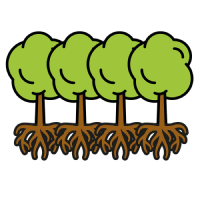When should I plant Bird Cherry hedging?̴Ì?
The best time to plant Bird Cherry plants is either at the beginning of spring or end of autumn, when the weather is cool and the soil is slightly moist.
How far apart should I plant Bird Cherry plants?
We recommend planting around 5 bare root plants per metre (20cm spacing). For pot grown specimens, 3 plants per metre is recommended (about a 30cm gap).
How to plant Bird Cherry:
The trick to planting any bare root plant is to ensure the roots are moist before going in the ground. With pot grown plants, it is not necessary to soak the root mass before planting, but a good watering is always recommended.
You should begin the process by dunking your bare roots in a bucket of water for at least 2 hours before planting (for pot grown, just skip this step). If you do not have a bucket to hand or have too many plants to put into buckets, you can also spray the roots using a garden hose/watering can.
Meanwhile, whilst the roots are soaking, you need to ensure you dig the trench/individual holes (if you haven't already). The hole should be at least twice the width of the plant's root ball/rot mass, but about the same depth. It is important to ensure that any weeds, grass, or other debris is removed from the planting are as you go along, too.
Following this, place the soaked roots (or remove the plant from its pot), and place into the hole(s). Ensure the stem is the same depth as it was in the ground/pot - the base of the stem should be around ground level. Fill back up with the excess soil, and pat down as you go along to secure the plant. We do also recommend watering the soil halfway through.
Once this is complete, water the plant very well and continue to regularly water for the next 1-2 years after planting (around 2-3 times per week, or more so during warmer weather).












